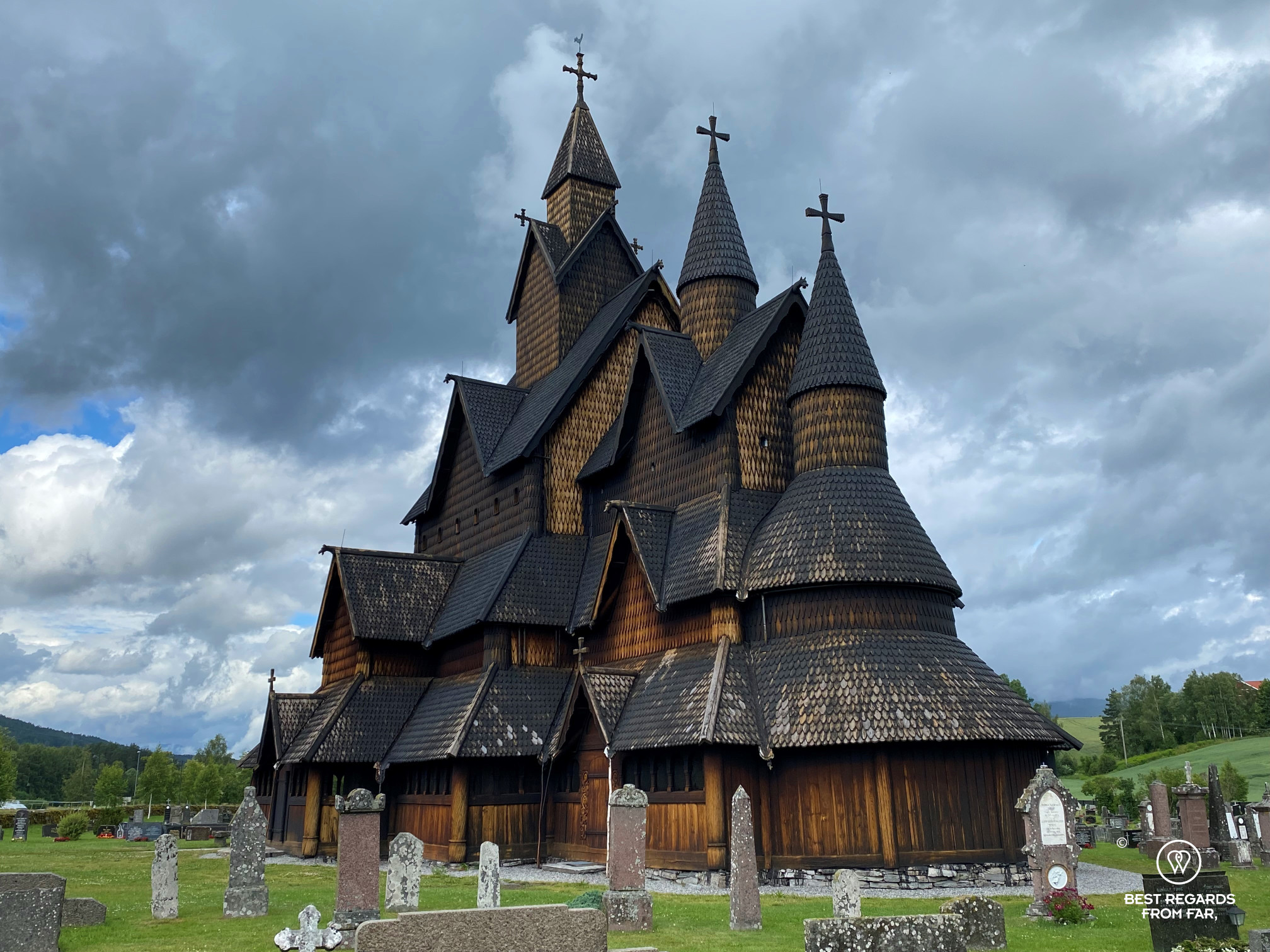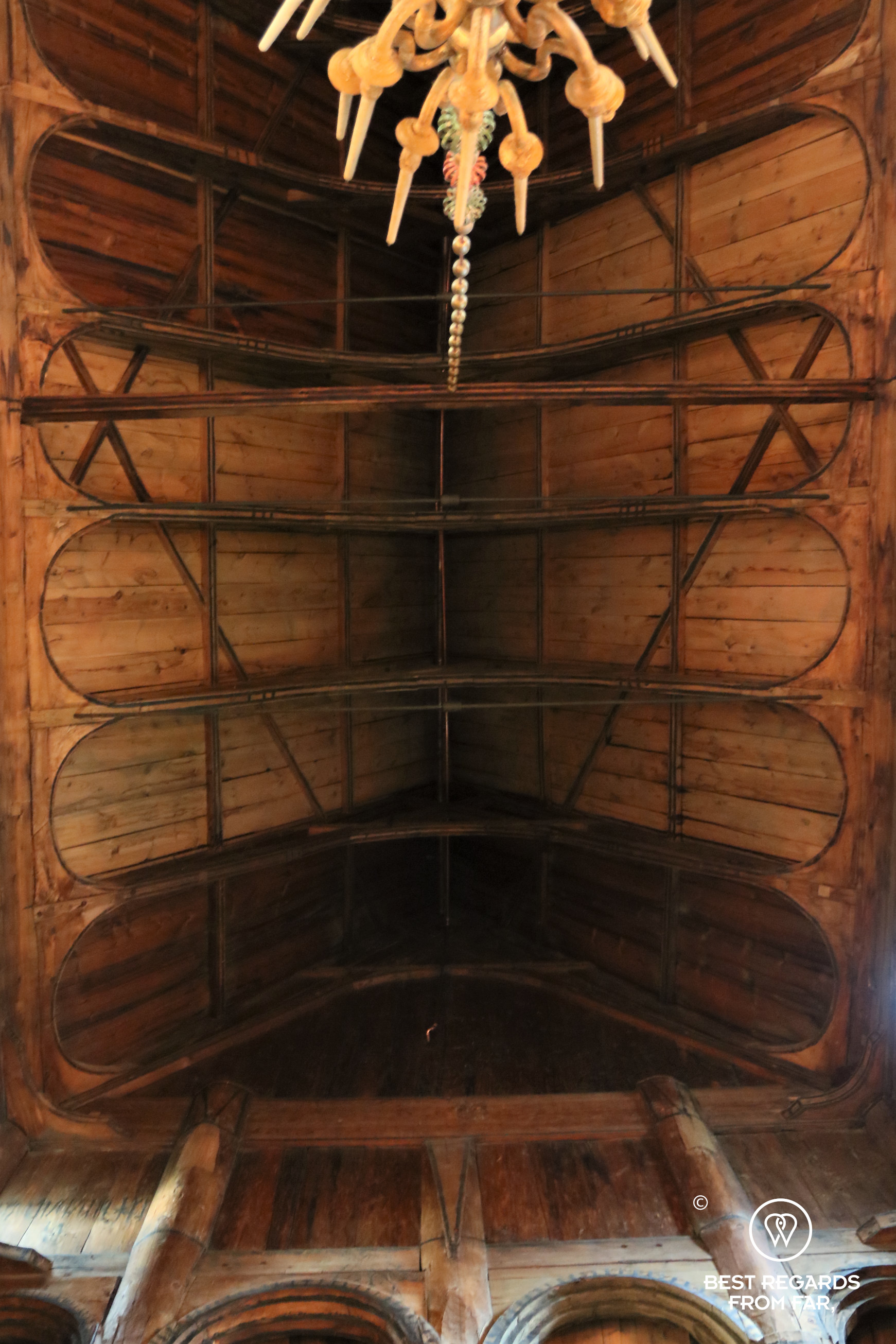Text: Claire Lessiau
Photographs: Claire Lessiau & Marcella van Alphen
As Norwegians like reminding it, their 100-percent wood Stave Churches are Norway’s unique contribution to the world heritage. If there used to be Stave Churches elsewhere in Northern Europe, it is Norway that has the largest amount of them today, and out of these 28, each is unique.
Pin it for later!
1. Stave churches are entirely made of wood, even the nails!
They can actually be taken apart. Parts can be replaced and then put back together. Or the whole church could be moved! Stave churches represent excellent timber engineering as they are 100 percent made of wood and have survived almost a millennium.


2. Stave churches were made only with axes, no saws.
Saws appeared only in 1550, after the reformation and about 400 years after the boom of Stave Churches. It means that Stave Churches were built exclusively with axes (making sharpening stones critical, and explaining why whetstone quarries were so important in Norway and also one of its top exports of ancient times).
Interestingly enough, during a renovation of Heddal Stave Church, archaeologists had the shingles machine-made, resulting in a complete failure! By working the shingles by hand with axes, the natural fibres of the wood are respected and the shingles hold together. The small Eidsborg Stave Church is covered by about 17,000 shingles… That gives an idea of the hard-work, dedication and faith that was put in these wooden cathedrals.



3. Stave Church literally means pillar church.
Stave churches have in common that they all have staves or main pillars. Their construction method had evolved and the churches that survived to this day have been laid on a stone foundation in order for the wood to not be in contact with the soil and not rot.
Then, the centennial-old pine trunks, serving as staves, were positioned on each side of a frame, completed by a large sill beam at the bottom. Notched planks were filling this U-shaped frame holding with groves. Lastly, the frame was closed by a long beam at the top of the wall.



4. Stave Churches can be found only in Norway… or almost!
Stave Churches used to be all around the Nordic world from Russia to Iceland via Sweden. In Norway, from an estimated 1,000 to 2,000 Stave Churches built between 1130 and 1350, only 29 have survived the centuries. One of them was sent to Poland, but it is Norwegian!
So out of the remaining 29 Norwegian Stave Churches, 28 are located in Norway.
For the purists, one, or more precisely, a part of its wall still stands in the UK, and there is also a tiny one close to Borås, in Sweden.
5. Girl power to keep the trolls out!
As any church, Stave Churches are always oriented in a similar way, with the altar pointing towards the East. As the evil comes from the cold North with its trolls, women used to sit on the left side to keep them out, as they were reputed to be strong with witchcraft and spirituality. Men would sit on the right side of the church, along the South wall.
To protect believers from evil, the North wall of Stave Churches is dark without any windows. Some small ones were sometimes added centuries later, after the reformation, to let a bit of light in. Masses were only candle-lit providing a very special atmosphere.
6. Narrow doors to ensure you are coming in alone!
Whether the priest’s, women’s or men’s entrances, they all have very narrow doors. A simple reason: no one could take the devil by one’s side into the church!


7. Cover up the stinking rich!
To get closer to God, the wealthy people were buried underneath the church, resulting in a horrible stench (and in the origin of the expression). After the reformation, the Lutherans rod the churches of their rich ornaments, covered the original Catholic paintings representing saints with floral motifs to help churchgoers focus on the preach. However, they barely dared touching the precious Catholic incense burners that are still found in many Stave Churches! Does that give you an idea of what the stench must have been like?
8. The carvings on and in Stave Churches are often a mix of Norse mythology and Christianity. And for sure, you know the blockbuster story!
When Olaf the Holy christianised Norway, ending the Viking Era in 1030, the Catholic religion slowly established itself using the Norse mythology as an anchor. With masses in Latin that no one could understand, it was critical to show pagans a similar value system with a fight between good and evil.
In many Stave Churches, dragons and snakes standing for evil are sculpted, as the Vikings used to fight evil with evil, dragon against dragon. In Heddal Stave Church, no less than 40 dragons are sculpted by the main entrance, fought by lions representing Christ. Inside, Sigurd, the dragon slayer (known as Siegfrid in Germany) and the Valkyrie Brynhild are sculpted on the thirteenth century bishop chair, itself guarded by two carved dragon heads to ward off evil powers.
For sure you know this Norse saga of Sigurd, the dragon slayer, hugely popular throughout Northern Europe and the role model for courage, vigour and honour. It inspired Richard Wagner’s The Ring of the Nibelung; and J.R.R. Tolkien’s The Lord of the Rings and The Hobbit uses some of the story lines, such as the ring, the sword and the dragon.


9. The church is made of pine & its pillars are made of 200-year-old trees! At least…
The technique?
Choose a tree, not any tree, but a slow-growing Norwegian pine, rather large – let’s say 200 to 300 years old.
Cut off its top and branches, and take the bark off (yes, it may require some climbing skills, so, hold on tight).
Let it sit for about 20 years (yes, it may require a bit of patience, and building a church was a long-term project). The trunk dries on its foot and then the sap dries out to protects the wood naturally: the wood is not treated, just prepared carefully.
Then, do not forget to tar your wood: the Stave Churches (just like the Viking drakes) were coated with tar to seal the wood and protect it from icy winters, rainy days, and sometimes, sunrays! The tar was made of pine resin and peat, a long process that is being lost, and that endangers the Stave Churches that have survived the centuries.
10. Stave Churches are reminiscent of ships.
After the Viking Age (800-1030), Norwegians had a long tradition of building in wood. Gazing up in a Stave Church, its roof construction is often reminiscent of an inverted hull.
11. It is a miracle Stave Churches are still standing (at least a few of them), so do yourself a favour, walk in & visit them: they are all unique & wonderful!
Most churches rotted away and were recycled as after the 1349 plague, there was hardly any resources left in Norway.
After the 1537 Reformation, Catholic Stave Churches started being torn down or transformed into Protestant parishes, ridding them of most of their Catholic symbols and riches.
In 1840, young Norway proclaimed a law stating that in any churches, as least a third of the attendants had to be seated: a death sentence for most rather small Stave Churches! Many were simply destroyed. Thankfully, some could be enlarged, losing a bit of their original character and making it to these days.
In the defence of the nineteenth-century churchgoers, the Stave Churches are not very well insulated and must have been ice-cold in the winter. Today, some are used as parish churches, but for summer services only!


Travel tips:
- For our Top 6 Stave Churches of Norway, check this article out!
- Even if the construction methods are similar, bear in mind that every Stave Church is unique. If you feel that seeing one is enough, reconsider!
- The folk museum in Oslo possesses some of the precious art work of Heddal Stave Church and is well worth a visit.
- Check out this interactive map for the specific details to help you plan your trip and more articles and photos (zoom out) about the area (short tutorial)!



Thanks for publishing this. Amazing and I have never heard of a Stave Church before.
Happy you have learnt something 😊 I must admit I was not too familiar with them before visiting Scandinavia. Feels very special to visit them.
Thanks for your read and comment!
Claire
Interesting read!
Thanks!! More coming soon about the best ones to visit 🤗